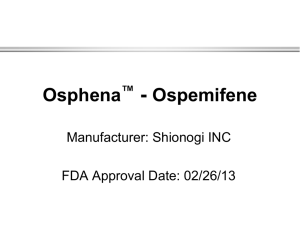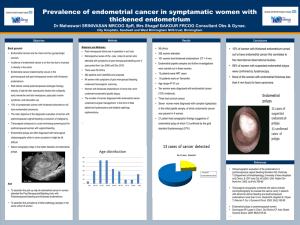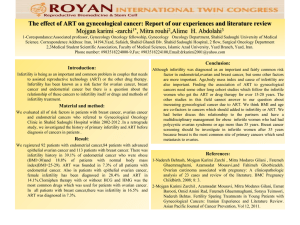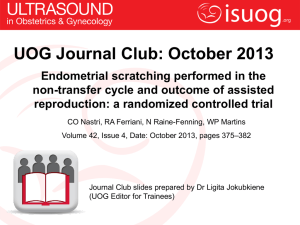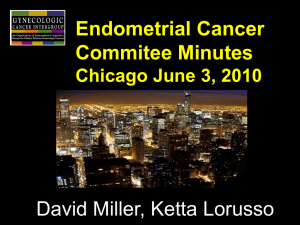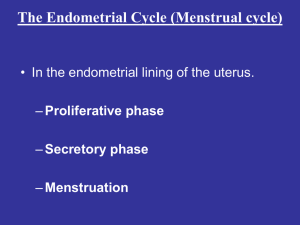New Drug update
advertisement
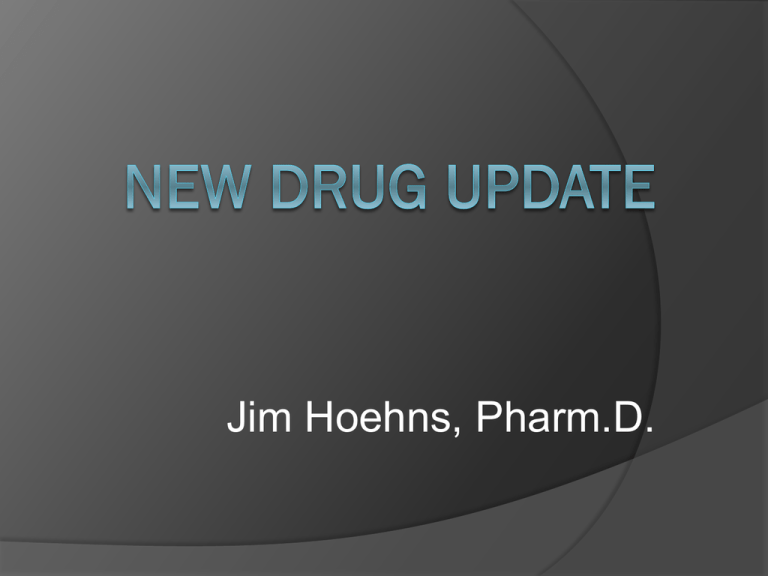
Jim Hoehns, Pharm.D. Outline Objective - To review the following new medications and determine their place in therapy: Vortioxetine (Brintellix) Levomilnacipran (Fetzima) Ospemifene (Osphena) Mirabegron (Myrbetriq) Vortioxetine (Brintellix) Indications: treatment of MDD MOA: SSRI Antagonist: 5-HT3 and 5-HT1A No effect on dopamine or NE Kinetics Half-life: 66 hrs Tmax: 7-11 hrs! Bioavailability: 75% Food: no effect on absorption Vortioxetine (Brintellix) Metabolism Extensive P450 metabolism ○ Seven different isoenzymes involved CYP2D6 – primary site; inactive metabolite ○ Poor metabolizers: 2X the [serum] Dosage Start: 10mg QD, then increase to 20mg QD Max: 20mg QD Discontinuing: ↓ to 10mg QD for 1 week before DC Forms: 5, 10, 15, 20 mg tablets Cost: 20mg QD #30 is $244 Vortioxetine (Brintellix) Drug-drug interactions Reduce vortioxetine dose by half if given with strong CYP2D6 inhibitor ○ Bupropion, fluoxetine, paroxetine, quinidine Bupropion: >2X increase in [vortioxetine] MAOIs: do not use within 21 days Increase dose with CYP inducers ○ Rifampin, carbamazepine, phenytoin Pregnancy: C Vortioxetine (Brintellix) Warnings/Precautions Serotonin syndrome: MAOIs, TCAs, fentanyl, lithium, tramadol, buspirone Suicidality in adolescents/young adults Increased risk of bleeding Hyponatremia Adverse reactions No effect on weight (short-term studies) ○ 1 year: 1.1kg weight gain No notable QTc effects No effect on psychomotor performance Vortioxetine (Brintellix) NNH: 71 NNH: 200 Vortioxetine (Brintellix) Nausea was more common in females Vortioxetine (Brintellix) Vortioxetine (Brintellix) Summary New SSRI with long half-life (66hrs) Not evaluated for use in pediatric patients Nausea is most common adverse reaction #1 reason for discontinuation Perhaps a favorable profile regarding sexual dysfunction Remember LONG Tmax if overdose situation No more efficacious than other SSRIs 5mg daily not effective in 6-8 week studies Levomilnacipran (Fetzima) Indication: treatment of MDD MOA: SNRI ○ Greater effect on NRI than SRI Kinetics Half-life: 12 hrs Food: no effect on absorption Metabolism: CYP3A4 ○ Metabolites eliminated via urine Levomilnacipran (Fetzima) Dosage Start: 20mg QD x 2 days, then 40mg QD Max: 120mg QD Renal impairment ○ Clcr 30-59 ml/min: do not exceed 80mg/day ○ Clcr 15-29 ml/min: do not exceed 40mg/day Forms 20, 40, 80, 120 mg extended-release capsules Cost Drug-drug interactions MAOIs, serotonergic drugs CYP3A4 inhibitors ○ Ketoconazole: 1.5 x ↑ AUC (max: 80mg QD Fetzima) Levomilnacipran (Fetzima) Pregnancy: C Warnings/precautions Suicidality in adolescents/young adults Serotonin syndrome Elevated BP Elevated HR Abnormal bleeding Controlled narrow angle glaucoma Urinary hesitation or retention Activation of mania/hypomania Seizures Discontinuation syndrome Hyponatremia Levomilnacipran (Fetzima) Adverse reactions 9% discontinued med due to ADR ○ Nausea was most common reason Increased heart rate Fetzima: ↑ 7.4 bpm Increased BP Fetzima: ○ SBP: 3.0 mm Hg increase ○ DBP: 3.2 mm Hg increase Levomilnacipran (Fetzima) Summary New SNRI for MDD Others: Desvenlafaxine (Pristiq), Duloxetine (Cymbalta), Venlafaxine XR (Effexor XR) Nausea and constipation are most common ADRs Not approved for use in pediatrics May be favorable regarding weight gain Increased HR and BP are relevant concerns Not approved for fibromyalgia Milnacipran (Savella) is Ospemifene (Osphena) MOA: estrogen agonist/antagonist Fourth approved SERM in USA Estrogen agonist on vaginal epithelium Agonist: bone and endometrial tissue Antagonist: breast tissue Indication: moderate to severe dyspareunia due to menopause Kinetics Half-life: 26 hrs Food: 2-3 x ↑ in absorption Metabolism: CYP3A4, 2C9, 2C19 Excretion: feces (75%) Ospemifene (Osphena) Dosage 60mg tablet QD with food Drug-drug interactions Estrogen: concomitant use not recommended Fluconazole: 2.7 x ↑ in [ospemifene] Warfarin: no interaction Pregnancy: X Ospemifene (Osphena) Warnings/precautions Stroke - unknown CHD - unknown Venous thromboembolism ○ Ospemifene: 1.45 per 1000 women ○ Placebo: 1.04 per 1000 women Endometrial CA ○ No case seen for up to 1 year Ospemifene (Osphena) Ospemifene Effects on the Uterus Outcome Ospemifene Placebo Endometrial thickening ≥ 5 mm 60.1 per 1000 21.2 per 1000 Any proliferative endometrium 86.1 per 1000 13.3 per 1000 Uterine polyps 5.9 per 1000 1.8 per 1000 Should women take a progestin?? Medical Letter suggests to follow closely for vaginal bleeding/spotting. Consider a progestin for those with risk factors for endometrial CA: obesity, hypertension, nulliparity, diabetes Ospemifene (Osphena) Adverse Events Adverse Event Ospemifene (N=1242) (%) Placebo (N=958) (%) Hot flush 7.5 2.6 Vaginal discharge 3.8 0.3 Muscle spasm 3.2 0.9 Hyperhidrosis 1.6 0.6 Ospemifene (Osphena) Efficacy Short duration trials (two 12 week trials) One long duration trial (52 weeks) Significant improvement in dyspareunia symptoms Ospemifene cost: $153 for a 30 day supply Ospemifene (Osphena) Summary New SERM with estrogen agonism on vaginal epithelium Small number of patients studied and for a short period of time Many unknowns about ADRs Too few patients to ascertain stroke risk Unclear long-term endometrial effects Even “common” ADRs are poorly defined Vaginal estrogens may still be preferred Mirabegron (Myrbetriq) Indications: overactive bladder with symptoms of urge incontinence, urgency and frequency MOA: Beta-3 adrenergic agonist Relaxes detrusor muscle; increases bladder capacity Mirabegron (Myrbetriq) Kinetics Half-life: 50 hrs Elimination: 25% renal (primarily active tubular secretion) Metabolism: multiple pathways ○ Limited role of CYP2D6 and 3A4 Food: ↓ absorption (20-50%) Dosage 25mg QD with or without food Clcr 15-30 ml/min: do not exceed 25mg QD Max: 50mg daily Forms 25 and 50mg extended release tablet Mirabegron (Myrbetriq) Drug-drug interactions Digoxin: ↑ [digoxin] 27% Myrbetriq is a moderate CYP2D6 inhibitor ○ ↑ [metoprolol] 229% ○ ↑ [desipramine] 241% ○ Similar concern for propafenone Pregnancy: C Warnings/precautions Increased blood pressure ○ Do not use if uncontrolled HTN Urinary retention if BOO or taken with anticholinergic meds for OAB Mirabegron (Myrbetriq) Afib: 0.2%; rate greater than with placebo Mirabegron (Myrbetriq) Drugs for OAB - Cost Mirabegron (Myrbetriq) - Summary First beta-3 agonist approved by FDA Indication: overactive bladder/urge incontinence Efficacy appears modest Side-effect profile is unique among OAB treatments May be better tolerated than anticholinergics Avoid if HTN, CAD, or arrhythmias Expensive: $200/month Long-term safety is unknown
